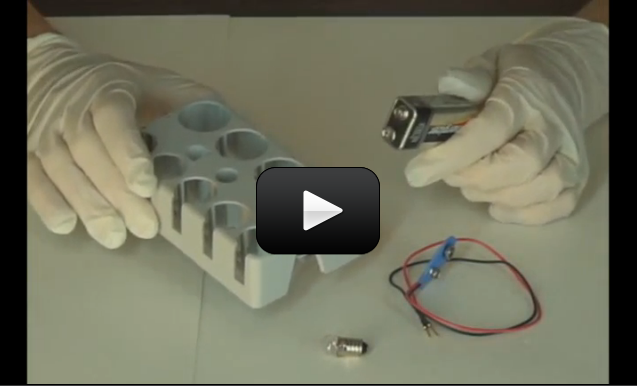Electricity. Chemistry. Nothing in common, have nothing to do with each other. Wrong! Electrochemistry has been a fact since 1774. Once electricity was applied to particular solutions, changes occurred that scientists of the time did not expect.
In this lab, we will discover some of the same things that Farraday found over 300 years ago. We will be there as things tear apart, particles rush about, and the power of attraction is very strong. We’re not talking about dancing, we’re talking about something much more important and interesting….we’re talking about ELECTROCHEMISTRY!
[am4show have=’p8;p9;p11;p38;p92;p25;p52;p91;’ guest_error=’Guest error message’ user_error=’User error message’ ]
Materials:
- Test tube rack
- 9V battery clip
- 9V battery
- Flashlight lamp
- Gloves
- Electrical wires
- Aluminum foil
- Water
- Sugar
- Salt
- Sodium carbonate (MSDS)
- Measuring spoon
When the salt sodium chloride (NaCl) mixes with water, it separates into its positively (Na+) and negatively (Cl-) charged particles (ions). When a substance mixes with water and separates into its positive and negative parts, it’s called a ‘salt’.
Salts can be any color of the rainbow, from the deep orange of potassium dichromate to the vivid purple of potassium permanganate to the inky black of manganese dioxide. Did you know that MSG (monosodium glutamate) is a salt? Most salts are not consumable, as in the lead poisoning you’d get if you ingested lead diacetate.
If you pass a current through the solution of salt and water, opposites attract: the positive ions are attracted tot he negative pole and the negative ions go toward the positive pole. These migrations ions allow electricity to flow, which is why ‘salt’ solutions conduct electricity.
C1000: Experiments 66-70
Download Student Worksheet & Exercises
Here’s what’s going on in this experiment:
Our experiment uses a saturated solution of table salt that is just sitting in a container minding its own business. That just won’t do! We must intervene. Our 9V battery pushes its voltage through the saltwater. That electric current tears the sodium from the chlorine. These positively and negatively charged ions rush about, looking for something they are attracted to. Opposites attract, so positively charged sodium ions find spending time with the negative electrode a treat. They are very happy together. Negatively charged chlorine ions are attracted to the positive electrode. The match is wonderful, and the negativity and the positivity somehow enjoy the time spent with each other.
NaCl –> Na+ + Cl–
Sodium chloride decomposes into sodium and chlorine ions
Cleanup: Clean everything thoroughly after you are finished with the lab. After cleaning with soap and water, rinse thoroughly. Chemists use the rule of “three” in cleaning glassware and tools. After washing, chemists rinse out all visible soap and then rinse three times more.
Storage: Place all chemicals, cleaned tools, and glassware in their respective storage places.
Disposal: Dispose of all solid waste in the garbage. Liquids can be washed down the drain with running water. Let the water run awhile to ensure that they have been diluted and sent downstream.
[/am4show]


Electricity travels when the atoms in a substance have extra electrons to carry that energy.
When something carries electricity, it is an electrical conductor. If an atom’s electrons are busy holding molecules together, then that substance can’t carry electricity, thus it is an electrical insulator. For instance, each atom in a copper wire has extra electrons, so copper is a good electrical conductor.
Pure, distilled water is an insulator. But water we encounter in day to day life contains other substances that make water electrically conductive.
The water in swimming pools contains many other substances that make it electrically conductive. Ocean water is conductive as well.
So, you said that water doesn’t conduct electricity. But what happens if lightning manages to zap a regular puddle of water? What about a public swimming pool? Would the chlorine effect the zap to become something more deadly? And what about the ocean water? Seeing it’s salty, would a lightning zap be fatal?
This rack came in the kit that used to be made by Home Training Tools. Any rack will work, I would recommend a regular test tube rack for these and future experiments!
Hi for this project, where can we find a rack like this one? Seeing many different racks other than this one. Thank you.